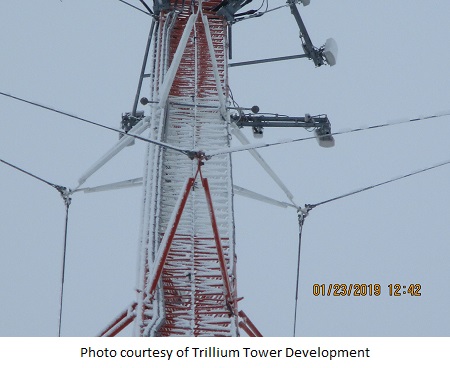The challenges of working in wintery conditions are welI-documented and usually well-handled by extra layers, a heated truck and a good thermos. But often the best decision is no climb at all until the conditions subside. The sub-zero freezing temperatures brought on by the latest winter blast often means the latter and has virtually halted tower work across the Upper Plains and Upper Midwest.
The cold temps can create frost on all structures hindering a safe climb for a technician, according to Barbara Houdek, CEO of Trillium Tower Development.
“Frosty towers have been problematic this year,” Houdek said. “Our policy is if the temps are around -10 or -15 with no wind chill, a 2-hour service call can be completed on a tower….such as changing a radio head on a sector or providing a re-lamp on a tower. Winds dictate our capabilities out in the field. Which is usually the case, so basically -10 to -15 is the limit to our willingness to work on site,” she said.
Houdek said Trillium allows several warm up breaks throughout the day. Each tech has arctic coats, bibs, arctic boots, gloves and other pertinent cold weather gear such as facemasks. A climber does have to avoid wearing to much clothing as sweating could cause more problems with the cold temps.
“Our goal is to avoid frostbite damage to hands, feet, noses, cheeks, etc.. Once a tech experiences frostbite, the ability to perform tasks in the cold diminishes. It can even cause a tech to terminate employment.” She said projects may be delayed for days or weeks before progress can commence but if there’s a “bright side,” it often means inventories can be completed, trucks get organized and cleaned up, and safety classes can take place.
Jim Tracy, CEO of Legacy Telecommunications and Chairman of the Board of NATE, has a mantra: “don’t do it for the money.”
“In other words,” Tracy told Inside Towers, “do not accept jobs where there is extreme risk for increased revenue. People who do not understand the risk are often willing to offer higher dollars and it is never worth the risk to our people.”
Tracy shared the safety checklist he uses at Legacy:
- Is there a risk of loss of life or 911 service affecting issue here?
- Are the go/no go decisions being made by the boots on the ground?
- Is the risk of climbing inherently more dangerous than lack of comms?
- Can the situation be engineered on a temp basis? Ground controlled?
- Is there a backup/out plan that is minutes instead of hours?
- What cold weather operational equipment is available? Sleds, snow cats, quads?
- Is there reliable backup survival equipment on site for shelter and heat?
- Is the shelter capable of withstanding a blizzard?
- What is the forecast? Travel, climbing and emergency access? Visibility concerns?
- How skilled in cold weather ops is the crew lead? The crew members?
No tower crews climb farther up into the cold air than the techs at Sioux Falls Tower, who specialize in tall tower work ascending to 1,000 feet and beyond. CEO Craig Snyder said when it comes to a cut off temp for shutting down work, zero Fahrenheit is a good rule of thumb.
“We don’t have a wind-chill standard since wind is almost always a factor on towers. Below zero and equipment begins to be a bigger hassle than trying to make it work. Particularly any equipment that used hydraulic fluid such as drum hoists, skid steers and excavators,” Snyder said.
Sioux Falls issues cold weather gear to first year employees. Otherwise they encourage their crews to use good judgment in what to wear and when to proceed and when to call it quits on cold days.
“The more you acclimate yourself to the local conditions, the more able you are to press forward in more difficult conditions. There are towers in the northern reaches of Alberta that need to be serviced year round just as there are in Florida. Climbers figure out the best ways to approach the work and continue to press forward the best they can,” Snyder said. “It makes summer work all that much more enjoyable.”
Snyder said they have far more workers quit their job in the winter months than in the summer months.
“This cold spell certainly will shorten our guy wires,” said Kevin Reski CEO, Great Plains Towers.
By Jim Fryer, Managing Editor, Inside Towers
January 31, 2019





Reader Interactions